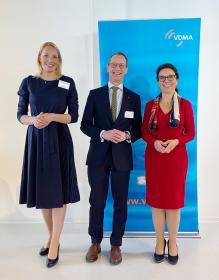Verband Deutscher Textilfachleute VDTF wählt Präsidium und Vorstand
Zum neuen Präsidenten des VDTF wurde Prof. Dr. Michael Rauch gewählt, der den Master-Studiengang „Sustainable Textiles“ an der Hochschule Hof leitet und dort auch das Lehrgebiet Verfahrenstechnik der Textilveredlung betreut. Er ist Vorstand der Regionalgruppe Bayern-Nord und Schatzmeister des internationalen Textilverbandes IFATCC (International Federation of Associations of Textile Chemists and Colorists).
Ihm zur Seite stehen aus dem bisherigen Vorstand Peter Schomakers, der bis zu seinem Ruhestand bei der Fa. Thies GmbH &Co. KG beschäftigt war und weiterhin im IHK-Prüfungsausschuss für Textilveredlung in NRW tätig ist, sowie Paresh H. Patel, geschäftsführender Gesellschafter der Chemie Impex, Reutlingen. Neu im Vorstand sind Harald Bäumle, Technischer Direktor der Wendler Einlagen GmbH & Co.KG, sowie Andreas Troscheit, bisher tätig für die CHT Germany GmbH in den Anwendungsbereichen Ausrüstung und Beschichtung, künftig bei der Fa. Brückner Textile Technologies GmbH &Co. KG in Leonberg. Weiter werden Lothar Hentz, Sales Manager für den Bereich DACH bei der Fa. Tanatex, B.V. Niederlande sowie Lukas Hartmann, Geschäftsführer Intex Consulting GmbH, im Vorstand mitarbeiten.
Die Wahlen im Verband Deutscher Textilfachleute VDTF e.V. standen im üblichen dreijährigen Rhythmus an. Laut Satzung dürfen Präsident und Vorstandsmitglieder nur einmal wiedergewählt werden, sodass aus dem aktuellen Vorstand nur zwei Personen erneut kandidieren konnten. Die offizielle Amtszeit des neuen Vorstandes beginnt nach der Mitgliederversammlung 2022 am 24. September in Nordhorn.
VDTF



































